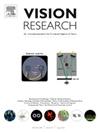老化人眼中的调节力
IF 1.4
4区 心理学
Q4 NEUROSCIENCES
引用次数: 0
摘要
人类晶状体的机械特性的变化会导致调节幅度的丧失,最终导致老花眼。虽然老化的人体晶状体的一些物质特性变化已经被绘制出来,但它们在体内的表征仍然存在挑战。文献中相互矛盾的发现突出了准确定义晶状体生物力学的复杂性。杨氏模量,前透镜和后透镜曲率,透镜厚度和折射率都是这些被充分研究的特性的例子。然而,对施加于晶状体以产生相应可调节振幅的力的了解仅限于少数年龄组。几十年来,对于老化的人眼,这些调节力的完整图谱仍然不完整。我们利用文献中已有的力学特性,建立了一个适用于10至70岁年龄组的晶状体力学模型。然后,通过模拟调节过程中透镜变形的有限元建模和光功率计算,创建了人类一生中调节力的分布图。我们发现太空舱所需的总赤道力呈s形下降,以达到报告的可调节振幅。这种下降并不表明晶状体依从性增加,而是反映了与年龄有关的施加力减弱的可能性。总作用力从10岁时的0.5牛到70岁时的接近零,在30岁到50岁之间急剧下降。本文章由计算机程序翻译,如有差异,请以英文原文为准。

Accommodative forces in aging human eye
Changes in the mechanical properties of the human crystalline lens over the years result in a loss of accommodation amplitude and eventually in presbyopia. While some material property changes of the aging human crystalline lens have been mapped, challenges remain in their in vivo characterization. Conflicting findings in the literature highlight the complexity of accurately defining lens biomechanics. Young’s modulus, anterior and posterior lens curvatures, lens thickness, and refractive index are examples of these well-studied properties. However, knowledge of forces applied to the crystalline lens for generating corresponding accommodative amplitudes has been limited to a few age groups. A full mapping of these accommodative forces over decades for the aging human eye remains incomplete. We used mechanical properties available in the literature to develop a mechanical model of the crystalline lens for age groups between 10 and 70 years. Then, finite element modeling and optical power calculations obtained from lens deformation during simulated accommodation were used to create a map of accommodative forces over the human lifespan. We found an S-curve-shaped decline in total equatorial forces required on the capsule to achieve reported accommodative amplitudes. This decline does not indicate increased lens compliance but reflects the possibility of age-related weakening of the applied force. The total force ranged from 0.5 N at age 10 to near zero at age 70, with a steep drop between ages 30 and 50.
求助全文
通过发布文献求助,成功后即可免费获取论文全文。
去求助
来源期刊

Vision Research
医学-神经科学
CiteScore
3.70
自引率
16.70%
发文量
111
审稿时长
66 days
期刊介绍:
Vision Research is a journal devoted to the functional aspects of human, vertebrate and invertebrate vision and publishes experimental and observational studies, reviews, and theoretical and computational analyses. Vision Research also publishes clinical studies relevant to normal visual function and basic research relevant to visual dysfunction or its clinical investigation. Functional aspects of vision is interpreted broadly, ranging from molecular and cellular function to perception and behavior. Detailed descriptions are encouraged but enough introductory background should be included for non-specialists. Theoretical and computational papers should give a sense of order to the facts or point to new verifiable observations. Papers dealing with questions in the history of vision science should stress the development of ideas in the field.
 求助内容:
求助内容: 应助结果提醒方式:
应助结果提醒方式:


